WOODS HOLE – “The ocean is changing,” said Scott Doney, senior scientist at the Woods Hole Oceanographic Institution and the principle investigator on a just-launched three-year study of how climate change will affect Buzzards Bay, as well as affect the fishing industry in Southern New England.
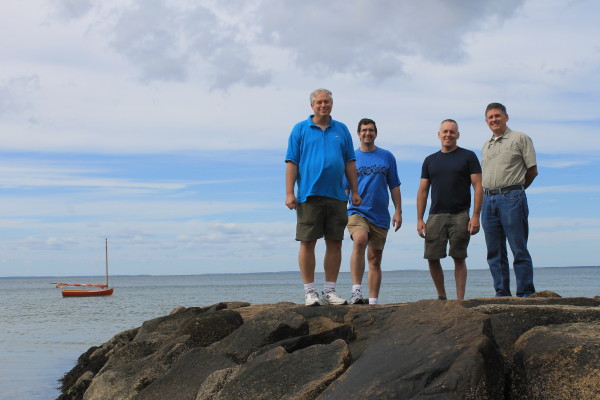
Senior Scientist Glen Gawarkiewicz, Senior Scientist Scott Doney, Associate Scientist Jeff Donnelly, and Senior Scientist Dan McCorkle. The four have received a $1 million grant from the MacArthur Foundation to study climate change. Buzzards Bay, a focus of the project, is behind them.
The project, which has a specific goal of engaging communities about expected impacts, has been awarded a $1 million grant from The John D. and Catherine T. MacArthur Foundation to develop science-based climate change adaption solutions for coastal communities.
“We were trying to find a place with an intersection of climate change, water quality issues, and sea level rise,” said Doney. The multi-pronged study will follow changes in climate and sea level; coastal water quality and ocean acidification in Buzzards Bay; and the effect of ocean warming on the fishing region from Long Island to Martha’s Vineyard.
The project includes the partnering of scientists with organizations such as the Buzzards Bay Coalition and the Commercial Fisheries Research Foundation and others to help communities anticipate change and prepare to adapt.
“By working with these partners, once we look at the science, we’ll find out, does this provide a basis for them to try to argue for changes in how we’re treating the ocean?” said Doney..
“One of the things we argue is that much of what we will learn from Buzzards Bay is probably applicable to lots of the East Coast,” said Doney. “We’re focusing here because we can basically shine a bright light on it, and hopefully understand what’s going on.”
“My job as a scientist is to inform decision makers,” said Doney. “That is everyone from individual homeowners deciding whether to buy a house, to business owners, to local government.”
One of the unique things about the project, said Doney and the three scientists leading specific parts of it – Senior Scientist Glen Gawarkiewicz, Senior Scientist Dan McCorkle, and Associate Scientist Jeff Donnelly – is that a major goal of the project is to engage various stakeholders.
“We sort of live in our ivory tower and do our research, publish and, move on,” said Donnelly. But this is different than a normal science grant, he said. “What’s not typically funded by those science grants is translating those results to decision makers. We’re going to translate our science in a meaningful way.”
Gawarkiewicz said, “It’s not just the science. Building relationships is a crucial thing to this.” Gawarkiewicz, who is the lead scientist on the fisheries portion of the grant, noted that commercial fishermen will help gather data.
The Buzzards Bay Coalition will help gather data for the Buzzards Bay portion of the grant. In fact, the coalition has been gathering information through citizen scientists for 20 years. Those data are valuable and will be incorporated into the overall analysis of expected changes in Buzzards Bay, said McCorkle.
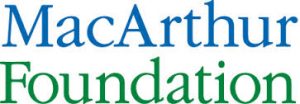 While scientists are used to doing research, McCorkle said the building relationships aspect of the project is “not an uncomfortable stretch, but it definitely is a stretch. If the only goal was to understand the science, the project would look different. But one of the express goals is to establish these links. That is one of the goals, not just part of the approach.”
While scientists are used to doing research, McCorkle said the building relationships aspect of the project is “not an uncomfortable stretch, but it definitely is a stretch. If the only goal was to understand the science, the project would look different. But one of the express goals is to establish these links. That is one of the goals, not just part of the approach.”
Besides the partners and the four lead scientists, Doney said the project will include “a very talented group of students and technical staff.”
Although the project will look at different things in Buzzards Bay, and in the fishing region between Long Island and Martha’s Vineyard, Doney said that adapting to changes in the ocean is a common theme and that the research from the various areas will fit together to explain a bigger picture.
![]() Sea Level Rise In The Funnel That Is Buzzards Bay
Sea Level Rise In The Funnel That Is Buzzards Bay
“Storm climate is changing and sea level is rising,” said Donnelly, the lead scientist on the sea level and coastal flooding part of the project. “You are a foot closer to the sea than you were in 1950, and the rate of sea-level rise is to accelerate.”
“We have a pretty good idea of how sea level is going to change,” he said. “There is uncertainty about how fast it will rise, but it will rise.”
“There are some specific sea level rise issues with Buzzards Bay,” said Doney.
“It’s one of the more vulnerable areas, and it’s close by,” said Donnelly. “It’s funnel shaped, so it traps storm surge,” he said. During Hurricane Bob in 1991, he said, the storm surge in Buzzards Bay was 12 feet.
“One of the things we’re doing is examining how hurricane climate has changed in the past, and how it may change in global climate models,” he said.
The information is more than just pure science, said Donnelly. It is useful to decision makers when translated in an understandable way, he said.
“One thing we hope to be able to communicate to folks is that the risk isn’t stationary,” said Donnelly. The ocean is changing and so is the risk, he said.
One example of how the information impacts policy, he said, is when the Federal Emergency Management Agency (FEMA) creates new flood hazard maps. “They refelect a worsening situation, and people are up in arms. There is a lot of economic impact in the change in the flood zone,“ he said.
“Because sea level is rising, when FEMA comes out with a new map, we can’t expect flood zones to get smaller,” said Donnelly.
Donnelly and the other scientists said that the communicating-with-the-public part of the grant takes them a bit out of their comfort zone. “Communicating science to a broad audience is not an easy task,” said Donnelly. “We’re not trained to interact with politicians. We’re literally speaking different languages. They have their acronyms, we have our acronyms.”
That is why Donnelly said much of the information he presents to the public will be web-based, for potential homeowners and others to make their own decisions. One thing Donnelly envisions developing is “a graphical display that shows how their risk may change.”
![]() Acidification and Water Quality In Buzzards Bay
Acidification and Water Quality In Buzzards Bay
“What’s exciting is we’re bringing together lots of little opportunities,” said Doney. “We are helping little projects that need additional funding. They don’t have the scientific support we can bring.”
One partner in the grant is the Buzzards Bay Coalition, an 8,000-member nonprofit organization with a goal of restoring and protecting Buzzards Bay. Using volunteers the coalition has been monitoring water quality in the summer, at various spots, since 1992, said Rachel Jakuba, science director for the coalition.
“It’s the largest coastal monitoring program in the state,” said Jakuba. “Our data has been used by the state in order to determine if a water body is impaired.” Water is sampled at almost 200 locations every two weeks in July and August for water temperature, salinity, water clarity, and nutrient concentrations, said Jakuba. Water is also sampled about every 5 days for dissolved oxygen, temperature, salinity, and water clarity from June to September, she said.
“To that set of samples, we’re going to do two things,” said McCorkle, the lead scientist on the ocean acidification part of the project. “We’re going to extend the duration of their every two week sampling. For whatever reason, if the climate is changing, the water warms up earlier in the spring or stays warm later in the fall. What was happening in the original sampling from the summer 20 years ago may now be happening on the shoulders (meaning spring and fall).”
“And at a subset of these sites, maybe eight to ten out of 40, we’ll be doing carbonate system sampling – essentially for acidification,” he said. “We won’t be measuring pH directly, but we will be measuring chemical properties that will allow us to calculate pH,” said McCorkle.
This testing will start to document the variability within Buzzards Bay, he said. “We expect the pH of the water near the bottom and oxygen to be related to each other. If that is seen to be the case, over the next year, then we can look back through the oxygen data collected by the Buzzards Bay Coalition and say it’s an extrapolation, then here’s how we think pH has changed over that time as well” said McCorkle.
This will be a deeper look at the data than it has ever been given, said Jakuba. “We’ve only dug into the data when there’s been a specific management need…. We’re very excited for this project. We haven’t had the resources to do a really vigorous look at the data that they’re going to do.”
The reason why understanding changes in pH is important, said McCorkle, is that “pH influences the biology of a bay or estuary in a lot of different ways.”
“One example,” said McCorkle, “is that shellfish have to work harder when the pH is lower. As the water gets more acidic, we think it is harder for shellfish to grow their shell. And there is a growing recognition that all sorts of biological processes depend on the pH of seawater. A fish’s ability to find prey might be impacted.”
Water is becoming more acidic, said Doney. “We’re trying to understand when we burn fossil fuels, what happens to all the carbon. A large fraction gets taken up by the ocean, and that’s good for the atmosphere. But it changes seawater chemistry.”
McCorkle said, “Coastal waters tend to be very variable. They change day to day, night to day, and season to season.” The range of natural variability is so high, he said, that “the only way we’re going to know (what goes beyond that range) is to start to measure.”
“That’s the nuts and boltsy sciency thing, a three-year snapshot of the pH in this coastal system,” said McCorkle. “But I’m not sure, for the MacArthur Foundation, that’s the most interesting thing. The most interesting thing is strengthening the link between the Buzzards Bay Coalition and the Woods Hole Oceanographic Institution. We are bringing the scientists with WHOI and having them sitting at table with citizens.”
Jakuba said, “It’s really exciting to have scientists interested and partnering with the Buzzards Bay Coalition. The scientific questions are important. This project is an excellent combination of basic scientific research but then applying that to management applications.”
“Waters have warmed substantially,” said Doney. “Some of the fishing community is very interested because this can affect their livelihood.”
In fact, WHOI scientists have teamed up with the Commercial Fisheries Research Foundation, a private not-for-profit foundation founded and directed by members of the commercial fishing industry, on the portion of the project looking into the effects of warming waters on the fishing industry.
According to Gawarkiewicz, who is the lead scientist on the fisheries and climate change part of the project, “the last couple of years, there has been increased temperature variability season to season and year to year, and that is drastically affecting fish distribution.”

Senior Scientist Glen Gawarkiewicz, Senior Scientist Scott Doney, Associate Scientist Jeff Donnelly, and Senior Scientist Dan McCorkle. The four have received a $1 million grant from the MacArthur Foundation to study climate change.
Understanding what is happening is important to the fishing industry, said Peg Petruny-Parker, Executive Director of the Commercial Fisheries Research Foundation. “They are seeing changes and they want to understand what is driving that change,” said Petruny-Parker.”They want to make business plans accordingly.”
“Change is what’s important to them,” said Doney. “They don’t want to care about what causes it.”
The National Marine Fisheries Service has been sampling water in the fishing area between Long Island and Martha’s Vineyard, said Gawarkiewicz, but they have “been unable to sample as much as they would like.”
The grant creates a partnership between WHOI scientists and commercial fisherman, with an intermediary of the Commercial Fisheries Research Foundation. “We’re giving scientific instruments to commercial fisherman through the research foundation,” said Gawarkiewicz. The foundation will give the instruments to fisherman, and the fisherman will take the measurements while they are fishing,” he said. “So it’s very cost effective,” said Gawarkiewicz.
“We’re telling them where to go,” said Gawarkiewicz. The area is a big rectangle that has been divided into six sub-regions, essentially boxes, and the idea is to measure for temperature and salinity in all six boxes, covering a large fishing area over the continental shelf, he said.
“We’ll be making monthly maps of temperature, salinity and density across the continental shelf. And then we’ll be using the maps to see how the ecosystem is changing. We’ll be taking them to management meetings. They will be used to improve computer models of the ocean circulation and computer models of the ecosystem,” said Gawarkiewicz.
“Fisheries management is increasingly using computer models,” said Gawarkiewicz. “You have to have a good starting point.”
Previous models are based on satellite data regarding surface temperature and surface color, he said. Fishermen will be given profiling instruments that will be dropped between 120 feet to 600 feet, he said. “That is the depth range we concentrate on.”
Having these instruments on the ocean is very valuable, said Gawarkiewicz. “The fishermen are always out there. We’ll get that continuous picture.”
Fishermen are very interested in helping gather data, said Petruny-Parker. “We think the physical environment out there is really affecting the resource,” she said.
Petruny-Parker said the Commercial Fisheries Research Foundation has created an application process to find fisherman who will be in the six different boxes in the studied fishing area at different times of the year. The six instruments will be rotated through different fishing boats at different times of the year, depending on when and where the boats go, she said. “This way, we have tremendous ability to collect data year round.”
“The hope is that they’ll see how useful the data is and they’ll want to collect more profiles, said Gawarkiewicz.
The instruments are not at all labor intensive, he said. “It’s pretty slick actually. We specifically chose an instrument that does automatic wireless uploads, using a tablet…. All they do is drop the instrument to the bottom and pull it back up. They have to turn the tablet on. The file automatically uploads.”
Petruny-Parker said the Fisheries Research Foundation connects the fisherman to the scientists. “These are two different worlds,” she said. “These are some of the best oceanographers in the world. But they do not, on a day to day basis, interact with commercial fisherman. We are committed to facilitating these kinds of relationships… Not all scientists have the ability to work with fishermen, and not all fishermen have the ability to work with scientists.”
Petruny-Parker and Gawarkiewicz both stressed that the learning will be going two ways, as fishermen understand the behavior of fish in ways that scientists sometimes don’t. There will be workshops and an opportunity for scientists and fishermen discuss what each is seeing.
“This is a project to watch,” said Petruny-Parker. “Fisheries management is one of the most contentious subjects, and it’s complicated, and it’s emotional. More often than not the fishing community is fighting with the science community…. The fishing industry often times feels the scientists are not getting the science right. But now they are are involved in collecting data and sharing day-to-day observations.”
For instance, she said, the fishermen may notice a specific behavior of a species. “They may be saying that squid show up earlier after strong currents, or after a storm, or something. It clues the scientists in to how to put this data into context,” said Petruny-Parker.
“That is pretty exciting science,” said Petruny-Parker. “When these interactions happen, it’s amazing. They learn from each other and in turn they advance the science.”
Gawarkiewicz called it, “a fantastic opportunity for fisherman and scientists to educate each other.”
“Fish are very susceptible to temperature,” he said. “This will enable fisheries managers to pick out the good years versus the bad years and let the fisherman fish more in a more favorable time period, and maybe cut back when the conditions are unfavorable,” said Gawarkiewicz.
“This is just one piece of the puzzle,” said Gawarkiewicz, “but something that cuts across the whole ecosystem. What we are doing compliments the work people are doing on specific species.”
“The thing that’s really important about this is there’s education going on in both directions,” said Gawarkiewicz. “We’re learning about changes going on in real time.”
“Climate change is a more challenging global problem,” said Doney. “Water quality is a local problem.”
There is an intersection of the two, he said, and this three-year project will help shine a light on the connections. As an example, he said, “as water warms up, algae grows faster.”
Gawarkiewicz said, “The seasons are changing in terms of their transitions. For the fishing community, he said, “the worst year for this was 2012. There was a very early phytoplankton bloom. The seasonal progression is changing. When we see shifts in the ecosystems, we want to understand how it’s relating to temperature changes.”
And McCorkle said, “What we’re going to do is pretty well outlined, but a part of that is listening. Everything you do is informed by what has gone before..Yes, this project has a finite duration, but you always have your eye on a longer story.”
Please like us on Facebook.
— Brian Tarcy
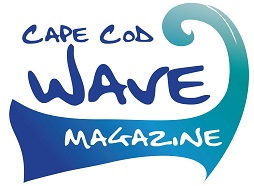
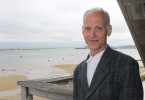

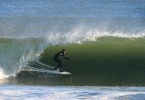
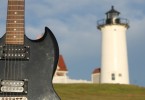
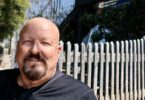

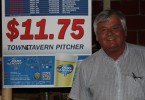
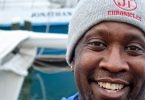

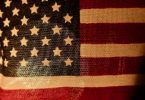
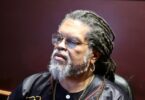

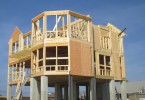

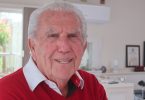


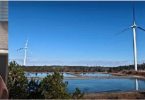



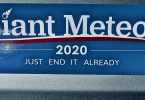
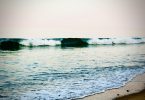
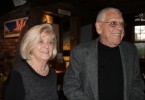
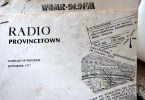

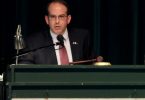
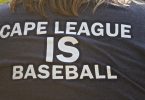
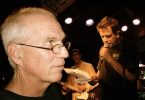
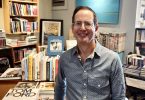
[…] Preparing for Climate Change–WHOI Scientists Get Million Dollar MacArthur Grant, capecodwave.com, November 13, 2014 […]